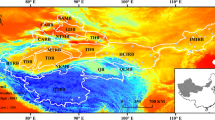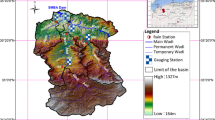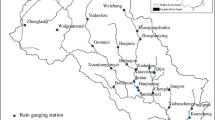Abstract
With the intensification of global warming, frequency of floods and droughts has been increasing. Understanding their long-term characteristics and possible relationship with large-scale meteorological factors is essential. In this study, we apply signal denoising, dimensionality reduction technique, and wavelet transform to study the spatiotemporal distribution pattern of drought/flood and its teleconnection with large-scale climate indices. Based on the precipitation data of 63 hydrological stations in the Taihu Lake Basin (TLB) for 54 years from 1965 to 2018, the standard precipitation index (SPI) was used as an indicator. The ensemble empirical mode decomposition (EEMD) and empirical orthogonal function (EOF) methods were used to explore the spatiotemporal evolution characteristics of droughts and floods. In addition, the cross-wavelet transform (XWT) method was used for teleconnection analysis. The results indicated that during 1965–2018, the SPI of the TLB showed quasiperiodic oscillations dominated by interannual oscillations (52.5%). Except for the trend of drought in spring, the basin showed a wetter trend at annual, summer, autumn, and winter scales. There were two main spatial modes (total 78.48% contribution) in the TLB, consistent across the region and reverse distributed from south to north. The dry areas were mainly in southern Zhexi and the northern Huxi sub-regions; the Hangjiahu and Yangchengdianmao sub-regions were prone to flooding. In addition, SPI was correlated with various large-scale meteorological factors, but the strength of the correlation had specific temporal and spatial heterogeneity. The research results can provide TLB reference values for water resource management and flood/drought disaster control.








Similar content being viewed by others
Data Availability
Not applicable.
References
AghaKouchak A, Hoerling M, Feldman D, Huxman T, Lund J (2015) Water and climate: recognize anthropogenic drought. Nature 524:409–411
Arduino G, Reggiani P, Todini E (2005) Recent advances in flood forecasting and flood risk assessment. Hydrol Earth Syst Sci 9:280–284. https://doi.org/10.5194/hess-9-280-2005
Byun HR, Kim DW (2010) Comparing the effective drought index and the standardized precipitation index. Options Méditerranéennes Séries A Mediterranean Seminars
Byun HR, Wilhite DA (1999) Objective quantification of drought severity and duration. J Clim 12:2747–2756. https://doi.org/10.1175/1520-0442(1999)012<2747:OQODSA>2.0.CO;2
Chang K-M, Liu S-H (2011) Gaussian noise filtering from ECG by wiener filter and ensemble empirical mode decomposition. J Signal Process Syst Signal Image Video Technol 64:249–264. https://doi.org/10.1007/s11265-009-0447-z
Dar J, Dar AQ (2021) Spatio-temporal variability of meteorological drought over India with footprints on agricultural production. Environ Sci Pollut Res. https://doi.org/10.1007/s11356-021-14866-7
Dogan S, Berktay A, Singh VP (2012) Comparison of multi-monthly rainfall-based drought severity indices, with application to semi-arid Konya closed basin, Turkey. J Hydrol 470:255–268. https://doi.org/10.1016/j.jhydrol.2012.09.003
Franzke C (2012) Nonlinear trends, long-range dependence, and climate noise properties of surface temperature. J Clim 25:4172–4183. https://doi.org/10.1175/JCLI-D-11-00293.1
Gao J, Shang P (2019) Analysis of complex time series based on EMD energy entropy plane. Nonlinear Dyn 96:465–482. https://doi.org/10.1007/s11071-019-04800-5
Grinsted A, Moore JC, Jevrejeva S (2004) Application of the cross wavelet transform and wavelet coherence to geophysical time series. Nonlinear Process Geophys 11:561–566. https://doi.org/10.5194/npg-11-561-2004
Guttman NB (1999) Accepting the standardized precipitation index: a calculation algorithm. J Am Water Resour Assoc 35:311–322
Hao Y, Liu G, Li H, Li Z, Zhao J, Yeh TJ (2012) Investigation of karstic hydrological processes of Niangziguan Springs (North China) using wavelet analysis. Hydrol Process 26:3062–3069
Hayes MJ, Svoboda M, Wilhite DA, Vanyarkho OV (1999) Monitoring the 1996 drought using the standardized precipitation index. Bull Am Meteorol Soc 80:429–438. https://doi.org/10.1175/1520-0477(1999)080<0429:MTDUTS>2.0.CO;2
Hu J, Liu Y, Sang YF, Liu C, Singh VP (2021) Precipitation variability and its response to urbanization in the Taihu Lake Basin, China. Theor Appl Climatol 144:1205–1218. https://doi.org/10.1007/s00704-021-03597-x
Huang NE, Shen Z, Long SR, Wu MLC, Shih HH, Zheng QN, Yen NC, Tung CC, Liu HH (1998) The empirical mode decomposition and the Hilbert spectrum for nonlinear and non-stationary time series analysis. Proc R Soc A-Math Phys Eng Sci 454:903–995. https://doi.org/10.1098/rspa.1998.0193
Huang X, Ma L, Liu T, Sun B, Chen Y, Qiao Z, Liang L (2021) Response relationship between the abrupt temperature change-climate warming hiatus and changes in influencing factors in China. Int J Climatol 41:5178–5200. https://doi.org/10.1002/joc.7123
Hui T, Borth H, Fraedrich K, Su B, Zhu X (2014) Drought and wetness variability in the Tarim River Basin and connection to large-scale atmospheric circulation. Int J Climatol 34:2678–2684
IPCC (2021) Climate change 2021: the physical science basis. Cambridge University Press, London
Jiang F, Dong Z, Luo Y, Liu M, Zhu Z (2021) Response of flood events to extreme precipitation: two case studies in Taihu Basin, China. Water Supply 21:1629–1648. https://doi.org/10.2166/ws.2021.001
Khan I, Lei H, Shah AA, Khan I, Muhammad I (2021) Climate change impact assessment, flood management, and mitigation strategies in Pakistan for sustainable future. Environ Sci Pollut Res 28:29720–29731. https://doi.org/10.1007/s11356-021-12801-4
Li X, Sha J, Wang ZL (2019) Comparison of drought indices in the analysis of spatial and temporal changes of climatic drought events in a basin. Environ Sci Pollut Res 26:10695–10707. https://doi.org/10.1007/s11356-019-04529-z
Liu PC (1994) Wavelet spectrum analysis and ocean wind waves. Wavelets Geophysics 4:151–166
Liu W, Zhu S, Huang Y, Wan Y, Wu B, Liu L (2020) Spatiotemporal variations of drought and their teleconnections with large-scale climate indices over the Poyang Lake Basin, China. Sustainability 12:3526. https://doi.org/10.3390/su12093526
Lorenz EN (1956) Empirical orthogonal functions and statistical weather prediction. sci rep.
Luo Y, Dong Z, Guan X, Liu Y (2019) Flood risk analysis of different climatic phenomena during flood season based on copula-based Bayesian network method: a case study of Taihu Basin, China. Water 11:1534. https://doi.org/10.3390/w11081534
Mckee TB, Doesken NJ, Kleist J (1993) The relationship of drought frequency and duration to time scales. In: 8th Conference on Applied Climatology American Meteorological Society, Anaheim.
Noorisameleh Z, Gough WA, Mirza M (2021) Persistence and spatial–temporal variability of drought severity in Iran. Environ Sci Pollut Res 28:48808–48822. https://doi.org/10.1007/s11356-021-14100-4
Palmer WC (1965) Meteorological drought. US Department of Commerce Weather Bureau Research paper.
Paulo A, Martins D, Pereira LS (2016) Influence of precipitation changes on the SPI and related drought severity. An analysis using long-term data series. Water Resour Manag 30:5737–5757. https://doi.org/10.1007/s11269-016-1388-5
Pei Z, Fang S, Wang L, Yang W (2020) Comparative analysis of drought indicated by the SPI and SPEI at various timescales in Inner Mongolia, China. Water 12:1925. https://doi.org/10.3390/w12071925
Philip S, Kew SF, Van Oldenborgh GJ, Otto F, O'Keefe S, Haustein K, King A, Zegeye A, Eshetu Z, Hailemariam K (2017) Attribution analysis of the Ethiopian drought of 2015. J Clim 31:2465–2486. https://doi.org/10.1175/JCLI-D-17-0274.1
Salehnia N, Ahn J (2022) Modelling and reconstructing tree ring growth index with climate variables through artificial intelligence and statistical methods. Ecol Indic 134:108496. https://doi.org/10.1016/j.ecolind.2021.108496
Salehnia N, Alizadeh A, Sanaeinejad H, Bannayan M, Zarrin A, Hoogenboom G (2017) Estimation of meteorological drought indices based on AgMERRA precipitation data and station-observed precipitation data. J Arid Land 9:797–809. https://doi.org/10.1007/s40333-017-0070-y
Salehnia N, Salehnia N, Torshizi AS, Kolsoumi S (2020) Rainfed wheat (Triticum aestivum L.) yield prediction using economical, meteorological, and drought indicators through pooled panel data and statistical downscaling. Ecol Indic 111:105991. https://doi.org/10.1016/j.ecolind.2019.105991
Shi X, Huang Q, Li K (2021) Decomposition-based teleconnection between monthly streamflow and global climatic oscillation. J Hydrol 602:126651. https://doi.org/10.1016/j.jhydrol.2021.126651
Torrence C, Compo GP (1998) A practical guide to wavelet analysis. Bull Am Meteorol Soc 79:61–78. https://doi.org/10.1175/1520-0477(1998)079<0061:APGTWA>2.0.CO;2
Vasileios M, Fabio F, Celine D, Iban A, Marco P, Luca M, Abdou A, Cesar CM (2018) Assessing floods and droughts in the Mékrou River Basin (WestAfrica): a combined household survey and climatic trends analysis approach. Nat Hazards Earth Syst Sci 18:1279–1296. https://doi.org/10.5194/nhess-2017-195
Vicente-Serrano SM, Beguería S, López-Moreno J (2010) A multiscalar drought index sensitive to global warming: the standardized precipitation evapotranspiration index. J Clim 23:1696–1718. https://doi.org/10.1175/2009JCLI2909.1
Voice ME, Hunt BG (1984) A study of the dynamics of drought initiation using a global general circulation model. J Geophys Res-Atmos 89:9504–9520
Wang X, Zhuo L, Li C, Engel BA, Sun S, Wang Y (2020a) Temporal and spatial evolution trends of drought in northern Shaanxi of China: 1960–2100. Theor Appl Climatol 139:981–982. https://doi.org/10.1007/s00704-019-03069-3
Wang Y, Xu Y, Song S, Wang J, Zhang J (2020b) Assessing the impacts of climatic and anthropogenic factors on water level variation in the Taihu Plain based on non-stationary statistical models. Environ Sci Pollut Res 27:22829–22842. https://doi.org/10.1007/s11356-020-08889-9
Wells N, Goddard S, Hayes MJ (2004) A self-calibrating palmer drought severity index. J Clim 17:2335–2351. https://doi.org/10.1175/1520-0442(2004)017<2335:ASPDSI>2.0.CO;2
Wu Z, Huang NE (2011) Ensemble empirical mode decomposition: a noise-assisted data analysis method. Adv Adapt Data Anal 1:1–41
Yang Q, Scanlon BR (2019) How much water can be captured from flood flows to store in depleted aquifers for mitigating floods and droughts? A case study from Texas, US. Environ Res Lett 14:054011. https://doi.org/10.1088/1748-9326/ab148e
Yilmaz M, Tosunoglu F (2019) Trend assessment of annual instantaneous maximum flows in Turkey. Hydrol Sci J-J Sci Hydrol 64:820–834. https://doi.org/10.1080/02626667.2019.1608996
Yin Y, Xu Y, Ying C (2009) Relationship between flood/drought disasters and ENSO from 1857 to 2003 in the Taihu Lake Basin, China. Quat Int 208:93–101
Yu Y, Shen Y, Wang J, Wei Y, Deng H (2021) Assessing the response of vegetation change to drought during 2009–2018 in Yunnan Province, China. Environ Sci Pollut Res 28:47083–47085. https://doi.org/10.1007/s11356-021-14804-7
Zhao H, Pan X, Wang Z, Jiang S, Liang L, Wang X, Wang X (2019) What were the changing trends of the seasonal and annual aridity indexes in northwestern China during 1961–2015? Atmos Res 222:154–162. https://doi.org/10.1016/j.atmosres.2019.02.012
Zhou Q, Jiang H, Wang J, Zhou J (2014) A hybrid model for PM2.5 forecasting based on ensemble empirical mode decomposition and a general regression neural network. Sci Total Environ 496:264–274. https://doi.org/10.1016/j.scitotenv.2014.07.051
Zveryaev II (2006) Seasonally varying modes in long-term variability of European precipitation during the 20th century. J Geophys Res-Atmos 111:D21. https://doi.org/10.1029/2005JD006821
Funding
This research was funded by the National Key Research and Development Program of China, grant number 2018YFC1508200.
Author information
Authors and Affiliations
Contributions
All authors have made a significant contribution to this research. Dingkui Wang and Feiqing Jiang conceived the research idea. Shengnan Zhu researched the corresponding methods. Dingkui Wang drafted the manuscript. Zengchuan Dong revised the paper. Zihan Ling edited the manuscript and processed the data. Jiayi Ma collected the data for analysis. All authors read and approved the final manuscript.
Corresponding author
Ethics declarations
Ethics approval and consent to participate
Not applicable.
Consent for publication
Not applicable.
Conflict of interest
The authors declare no competing interests.
Additional information
Responsible editor: Marcus Schulz
Publisher’s note
Springer Nature remains neutral with regard to jurisdictional claims in published maps and institutional affiliations.
Rights and permissions
About this article
Cite this article
Wang, D., Dong, Z., Jiang, F. et al. Spatiotemporal variability of drought/flood and its teleconnection with large-scale climate indices based on standard precipitation index: a case study of Taihu Basin, China. Environ Sci Pollut Res 29, 50117–50134 (2022). https://doi.org/10.1007/s11356-022-19329-1
Received:
Accepted:
Published:
Issue Date:
DOI: https://doi.org/10.1007/s11356-022-19329-1




